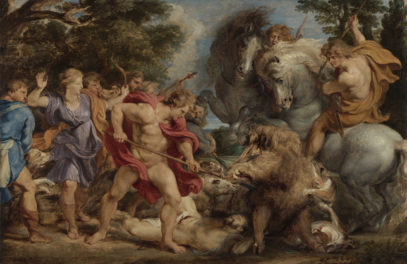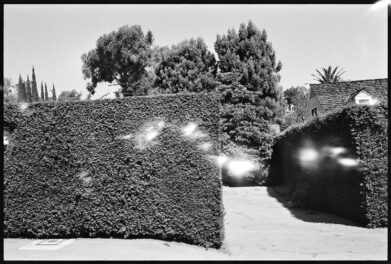
Card collaged by Joseph Cornell, enclosed with his letter to Susanna De Maria Wilson dated February 17, 1963. The Getty Research Institute, 2014.M.30
Joseph Cornell (1903–1972) is best known for his assemblages made of objects found in bookshops and thrift stores, arranged eclectically in simple shadow boxes and usually fronted with a glass pane. He also created flat collaged works and experimented with film. The dreamlike, irrational juxtaposition of dissimilar things, inspired by Surrealism, and the evocation of a sense of nostalgia, drawn from nineteen-century Romanticism, formed the underlying basis of his art. Cornell was also influenced by French symbolist writers, American Transcendentalism, and Christian Science.
Cornell was a self-taught artist who spent most of his life in a small house on Utopia Parkway in the working-class neighborhood of Flushing, Queens, along with his mother and younger brother, Robert, who suffered from cerebral palsy. In 1940, after years of struggling to make a living and support his family, Cornell decided to devote all his time to art, so he set up a workshop in the basement of his house. As caring for his family claimed more and more of his time, he hired assistants to help him organize material, make artworks, and run errands. One of his assistants was Susanna De Maria Wilson, who was then married to the American minimalist sculptor Walter De Maria.
The Getty Research Institute recently catalogued and digitized a collection of thirty-three letters by Cornell, which he sent between 1963 and 1968 from his house in Flushing to De Maria Wilson at her various addresses in New York City. The letters not only reflect the nature of their relationship—both professional and personal—but also include various collaged elements, objects, and artistic flourishes, making them a form of art unto themselves.
A Working Relationship with an Underlying Affection
The letters disclose various aspects of Cornell and De Maria Wilson’s working relationship. One of De Maria Wilson’s tasks was to acquire source materials for Cornell’s collage and assemblage work. Cornell wrote directions on where to go to find such materials, as well as what kind of imagery appealed to him; sometimes he even included sample images. One such example is a brown paper bag featuring a hand-drawn map to a magazine store on 54 W. 42nd Street in Manhattan.

Brown paper bag enclosed with Joseph Cornell’s letter to Susanna De Maria Wilson dated March 27, 1963. The Getty Research Institute, 2014.M.30
In addition to giving guidance and instructional information in the letters, Cornell occasionally shared insights into his artistic thoughts and inspirations with De Maria Wilson. For instance, in a letter postmarked March 27, 1963, he wrote about the mystery of sylphs and sensuality. In another letter from April 5, 1963, he enclosed a lengthy note about three of his dreams.

Joseph Cornell’s note about his dreams handwritten on two leaves of onionskin paper, numbered Sylph #1 and Sylph #2, and clipped together. Enclosed with his letter to Susanna De Maria Wilson dated March 27, 1963. The Getty Research Institute, 2014.M.30
Sometimes, the letters and cards are personal in nature, such as a folded card illustrated with a drawing of a cupid by Francesco Mazzola, better known as Parmigianino. Inside, the card is collaged with two small photos of De Maria Wilson’s face. Each photo is cropped around an eye and her forehead, creating an effect of secrecy or maybe even voyeurism, and a tiny heart made of red aluminum foil is affixed below one of the images. The cupid and the red heart hint at an underlying affection in Cornell’s relationship to De Maria Wilson. Cornell mailed the collaged card in an envelope that also contained another, smaller envelope postmarked in approximately 1870 in Vezzano in Liguria, Italy. Inside this smaller envelope he put a typed note on pink onionskin paper that reads: “Were you not hitched I’d offer you a kiss for each image, — instead just one!” He also sealed the envelope with a tiny red foil heart and a blue foil dot.

Front of card collaged by Joseph Cornell with drawing of a cupid by Francesco Mazzola

Inside of card collaged by Joseph Cornell, enclosed with his letter to Susanna De Maria Wilson dated February 17, 1963. The Getty Research Institute, 2014.M.30

Items enclosed with Joseph Cornell’s letter to Susanna De Maria Wilson dated February 17, 1963. The Getty Research Institute, 2014.M.30
Personal touches reside in another note by Cornell, a handwritten note in red and blue that begins with the words “Thank you for the WARMTH.” The card is attached with a clip and blue ribbon to a tag illustrated with a stamp of a potbelly stove.

Handwritten thank-you note by Joseph Cornell enclosed with his letter to Susanna De Maria Wilson dated 1968. The Getty Research Institute, 2014.M.30
Stamps, Seals, and Other Visual Effects
The aesthetic composition of the letters is just as important as their textual and artistic content. In general, the pieces are strongly visual in their orientation, and even the more mundane-seeming letters and postcards feature stamps affixed with great care to achieve a deliberate effect, such as this envelope stamped along the left and upper margins with ten half-cent Benjamin Franklin stamps.

Envelope from a letter by Joseph Cornell to Susanna De Maria Wilson dated February 17, 1963. The Getty Research Institute, 2014.M.30
The postmarked envelopes contain printed matter, such as greeting cards and clippings from magazines, which were often inserted in smaller envelopes, wrapped in tissue paper, stitched or clipped together, and collaged with stamps, seals, foil stickers, and small photographs. Cornell enclosed several small objects, including a bird call whistle, pressed grass, a plastic toy mirror, a piece of perforated metal, and rusty nails.
The brown paper bag mentioned above is also an example of such nesting of items. It contains several other objects, such as a torn white tissue with three inked-stamps depicting a five-pointed star, a hand with a pointing finger, and a woman’s face; a folded blue paper sheet with text typed and corrected by hand in black ink; and several illustrations of women torn from magazines.

Items enclosed with Joseph Cornell’s letter to Susanna De Maria Wilson dated March 27, 1963. The Getty Research Institute, 2014.M.30

Typescript with corrections by Joseph Cornell enclosed with his letter to Susanna De Maria Wilson dated March 27, 1963. The Getty Research Institute, 2014.M.30

Illustrations of women enclosed with Joseph Cornell’s letter to Susanna De Maria Wilson dated March 27, 1963. The Getty Research Institute, 2014.M.30
This white blank envelope with a broken 1958 Japanese stamp seal contains a Swiss warbler bird call whistle, evoking one of Cornell’s various interests: birds.

The recto of an envelope with a broken 1958 Japanese stamp seal. Visible inside is a paper sleeve containing a Swiss warbler bird call whistle. Enclosed with Joseph Cornell’s letter to Susanna De Maria Wilson dated January 21, 1963. The Getty Research Institute, 2014.M.30
As any given letter is usually contained within multiple envelopes wrapped in tissue paper and stitched or clipped together, the experience of reading and viewing the letters is a layered one that is similar to looking at collage and assemblage art. Cornell took the technique of layered arrangements from collage and assemblage and adapted it to the more temporally ordered sequential mode of reading. From this perspective, Cornell’s letters are as much a collection of works on paper or mail art as they are textual documents.
In addition to the letters, the Getty Research Institute digitized a small group of printed ephemera and notes from Cornell’s personal collection that relate to four historic film screenings that took place in 1963 at 9 Great Jones Street in New York City, a space run by Walter De Maria and Robert Whitman. These documents provide information about the screenings, including who attended. Also included are a few letters written by others after Cornell’s death. De Maria Wilson kept these letters at her house in a painted wood box, which Cornell had once seen in a Manhattan store and asked her to purchase.

Painted wood box in which Susanna De Maria Wilson stored letters in her home. The Getty Research Institute, 2014.M.30
Viewing Cornell’s letters in person requires curatorial permission, but their digital surrogates are now accessible to on-site readers in the Research Library. To inquire about viewing the digital images, please contact the Getty Research Institute’s Library Reference Desk.

See all posts in this series »




Comments on this post are now closed.